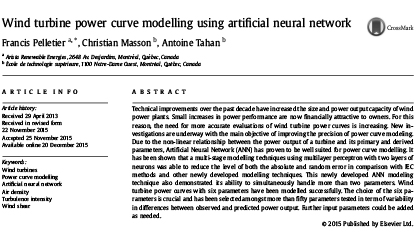Artificial neural networks with six inputs have been developed in order to identify an accurate model site-specific wind turbine performance. Results of this modelling technique were compared with parametric. non-parametric. and discrete methods. For the two turbines studied. it has been demonstrated that the strategic incorporation of 6 inputs in a multi-stage ANN modeling technique. the possibility to incorporate further variables as needed and the decrease in the level of errors is able to outperform previously developed models. With further data available (e.g. wind speeds above hub height. wind veer. etc.) more inputs could have been easily added into the model and potential further lower the errors levels obtained. This is rendered possible due to the facts that low interactions between inputs have been found in the two sites considered and that power normalization between each modelling steps is performed.
These results demonstrate the potential of the two-layer MLP neural network to properly model the power performance of wind turbines which could be easily used by maintenance application focus on underperformance detection [35]. Furthermore. it has been shown that the choice of the six parameters is crucial and has been selected amongst more than fifty potential parameters tested in term of variability in differences between observed and predicted power output.
 Iran Energy News Oil, Gas, Petrochemical and Energy Field Specialized Channel
Iran Energy News Oil, Gas, Petrochemical and Energy Field Specialized Channel




